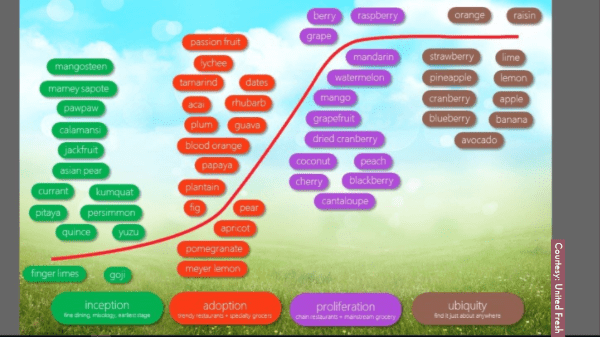If it seems like restaurant trends are moving faster, you’re right.
The typical cycle of a menu trend from inceptions to adoption to proliferation to ubiquity has shortened from 12 years not long ago to 6 years today, said Mike Kostyo, trendologist at Datassential, which collaborates with the United Fresh Produce Association BB #:145458 on its quarterly Fresh Insights for Foodservice.
Kostyo led a webinar May 17 that revealed that acceleration of trends and expanded on the quarterly report.
Datassential’s Menu Adoption Cycle follows trends through an established life cycle.

It defines the stages as:
Inception: Trends start here. The birth of a trend typically originates in fine dining or ethnic independents. Inception-stage trends exemplify originality in flavor, preparation, and presentation. Cutting-edge chefs operate in this realm, often giving way to the next trends. Examples: Romanesco, yuzu, rillettes.
Adoption: Casual dining and fast-casual independents expand the audience for fine dining trends by offering them at a lower cost and with simpler prep methods. Adoption-stage trends are still unique and differentiated, often characterized by premium ingredients, interesting prep, and creative plating. Examples: Acai, duck, charcuterie.
Proliferation: Now it’s mainstream, as casual dining, fast-casual, and sometimes QSR chains help popularize a trend for a mass audience. Proliferation-stage trends are adjusted to appeal to a broader population, often by combining them with popular applications (on a burger, pasta, etc). Examples: Kale, grits, smoked cheeses.
Ubiquity: Trends reach maturity, and are now common across the industry, with midscale restaurants generally acting last. While these trends are often altered to appeal to the mainstream, their roots are still recognizable. Ubiquity trends are well-suited for line extensions and to add punch of creativity to old favorites. Examples: Arugula, chipotle, tater tots.
Kostyo said his group can chart many produce items to their time in the cycle, and as one would expect, the most well known are in the ubiquity section.


He said inception often starts at the fine dining level, where chefs can experiment with lesser known ingredients.
The foodservice report is free for United Fresh members and can be downloaded here.


